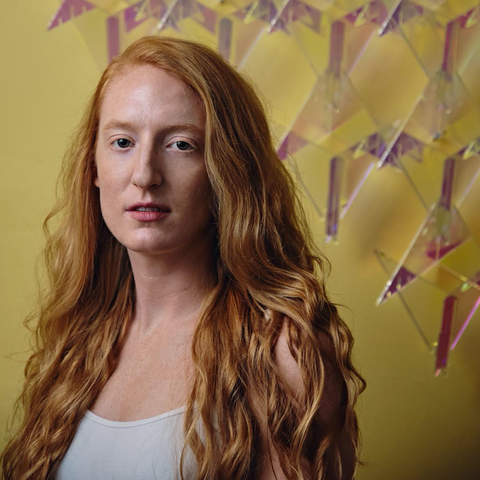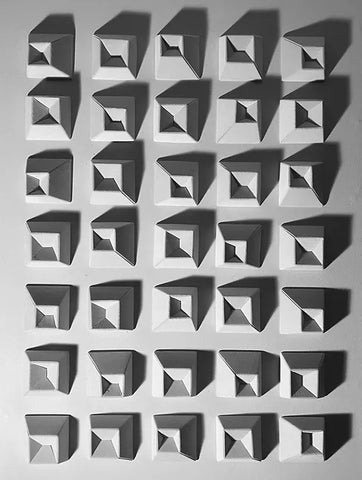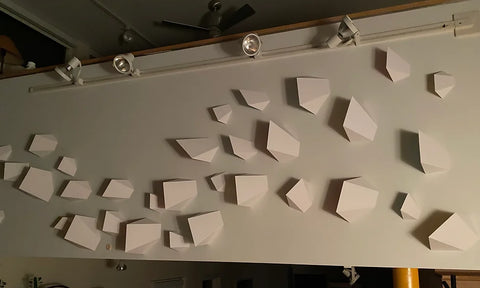
Eliza Redmann (she/her/hers)
Durham, NC
“Both the function and aesthetic of my work are born out of experiencing disability.”
Eliza’s art marries her training as an architect with her experience living with a traumatic brain injury to create 3D work that is unique, scalable, and incredibly meaningful. Growing up in Minnesota and Wisconsin, she always found herself drawing and doodling, but never took any proper art classes. However, Eliza saw this as a benefit to her creative development. She shares, “I believe this helped me to become a more creative person because I had no preconceived notions about style, methods, and frameworks for art. I sense an understanding of creativity on an intuitive level and my work comes from that place.” Additionally, the ‘creative gene’ runs in her Mom's side and has always been valued and nurtured in her family.
Eliza decided to follow her passions for art and moved to North Carolina for graduate school in 2013, where she attended North Carolina State University in Raleigh. With great focus and effort, she earned her graduate degree in architecture and began working full-time as an architect. This education laid the foundation for her artistic craft and design.
However, her world was suddenly upended when she experienced a serious car crash in 2018, which resulted in a severe traumatic brain injury. This major event derailed her health, personal life, and career in an instant. Eliza was plunged into survival mode, struggling to meet her basic needs. Dealing with unrelenting head and neck pain along with extreme changes in her balance and vision, Eliza found herself compromised in her ability to return to her career in corporate architecture. Faced with deep uncertainty about her future, and a long road of rehabilitation ahead, Eliza did something she knew herself capable of – she began creating. She expresses, “While very sick and disabled and during the beginning of the pandemic, I began making art to give my life, health, and spirit a forward trajectory.”
What began as a therapeutic practice slowly morphed into a new business. Living with disability, Eliza had a new lens through which to explore her architectural interests. For example, since the accident, Eliza manages persistent visual disturbances which affect her ability to perform daily activities such as reading and ‘screen-time’. One way that these disturbances manifest is that her mind perceives patterns as swimming or moving on their own accord – much like an optical illusion.
Instead of resenting this, Eliza leaned into it and incorporated the experience into her new work. She explains, “I seek to capture the structure of regular patterns and shapes, while adding a layer of geometric information which the eyes and brain can't quite make sense of.” In a way, Eliza is mimicking her own experience for the aesthetic experience of the viewer. She goes on to say, “This visual disorientation is designed to challenge viewers to perceive outside of what is normal or traditional, just as I must now live, adapt, and navigate the world in new ways.”
Additionally, her work is functionally driven by her experience of auditory overwhelm. Her brain injury caused extreme sensitivity to noise, and she found herself unable to function in loud spaces. “Suddenly having an accessibility barrier to most of the places where I had once enjoyed spending time motivated me to explore producing acoustical art. I have since found that controlling sound in a visually appealing manner can provide widespread benefits for various users and applications,” she explains. Born out of responding to her own needs, Eliza now found that many other individuals and companies were searching for sound-minimizing solutions as well.
With patience, practice and hard work, Eliza began launching her new line of designs, functional geometric patterns and paper art that can be translated into a diverse range of sculptural applications. Her process involves typically sketching out ideas first, then translating them into 3D models on the computer. Eliza says the best designs come to her when she is relaxed and at ease or having new experiences. She also lets her rich curiosity lead her. “Most of what goes through my head when I'm creating designs is, "I wonder what that will be like," or "what if this shape does that", she explains. A sense of play and curiosity is central to her process.
After mapping out the design, Eliza often turns to creating the work in her favorite material: paper. With its incredible versatility, accessibility, and forgiving nature, it is a wonderful material to experiment with and envision the effects of a small pattern on a greater scale. Part of the brilliance of Eliza’s work is how it lends itself to scalability, making it an option for so many spaces, regardless of differences in size and design.
Eliza explains, “the bedrock of my practice is the use of a small number of simple forms which, when created and compiled physically, can be arranged to create complex geometries.” Most of her inspiration comes from observing her environment and picking up on existing patterns. Be it in nature, or our man-made environments, she remains curious about what existing two-dimensional patterns could become when made three-dimensional. From there, she uses her architectural modeling with her site-specific design and visualization skills to create unforgettable commissioned projects that are functional, aesthetically pleasing and impactful.
While trailblazing her new career, Eliza still focuses on her wellbeing. “I've given myself permission to reimagine and restructure my days however I best see fit - prioritizing my health above all else,” she exclaims proudly. Being cognizant of her body’s boundaries and needs, Eliza has found that she is able to balance her creative purpose with her recovery. She goes on to say, “Because my story is one of resilience and overcoming misfortune, I seek to give permission and hope to others so that they may also rise above their circumstances and claim their dreams.” Her initiative to own and prioritize her physical and mental health remains her most significant accomplishment.
Eliza hopes ArtLifting will elevate her craft and expose her work to new avenues, while valuing and respecting her experiences. “ArtLifting presents a unique opportunity to proudly own my disability and capitalize on it. It is a great way for me to connect with compassionate, understanding industry professionals without needing to over-explain myself or my limitations,” she states. She dreams of establishing product lines, creating large-scale installations and achieving a healthy work-life balance “where I can travel, be inspired, and create from a place of abundance and generosity.”
Outside of her daily work, Eliza is apart of the leadership of a community design organization called Durham Area Designers, who advocate for sound urban planning and design of the public realm in the city of Durham, NC. She is very passionate about income inequality and finding ways to improve this in order to make waves on other, interconnected social issues. When she is not creating or advocating, she loves to get out into nature, travel, go rollerblading or ride her bike. She also enjoys the farmers market on Saturday mornings and growing her relationship with her partner and close friends. ArtLifting is excited for Eliza to broaden her audience and share her unique story with the community.
Originals by Eliza Redmann (she/her/hers)
ArtLifting champions artists impacted by disabilities and housing insecurity by connecting their art with socially-conscious customers . Learn more here.


